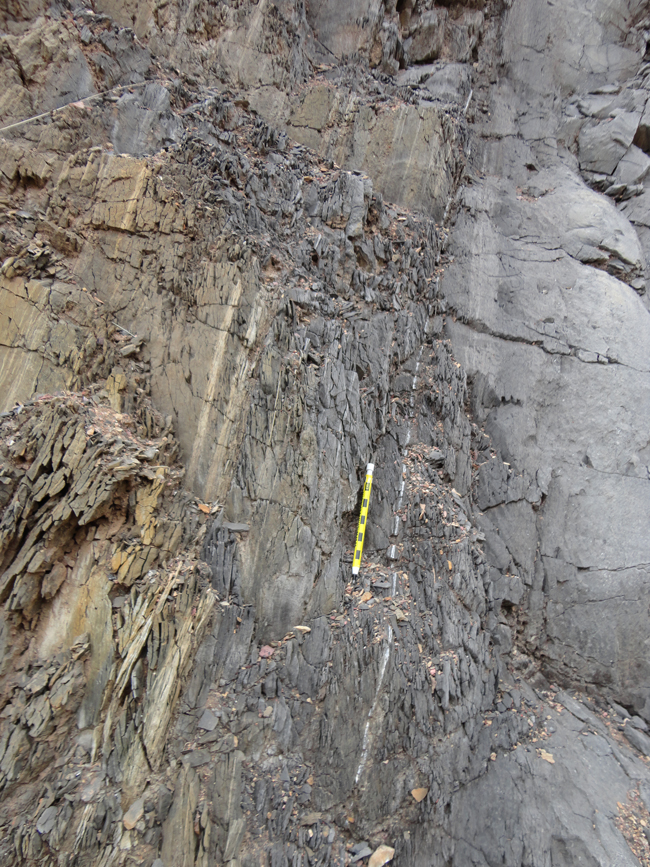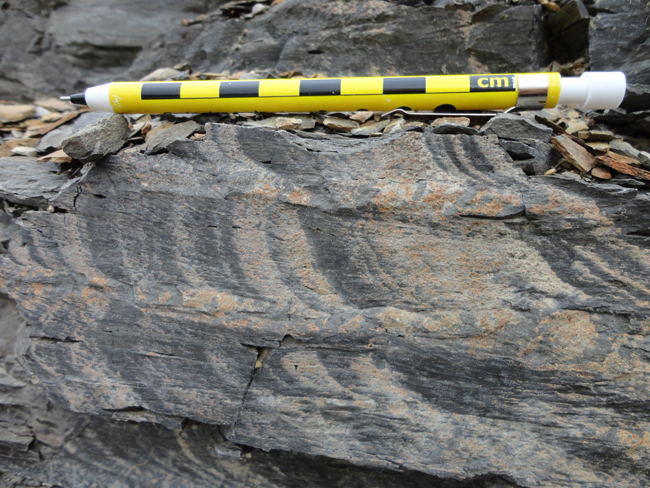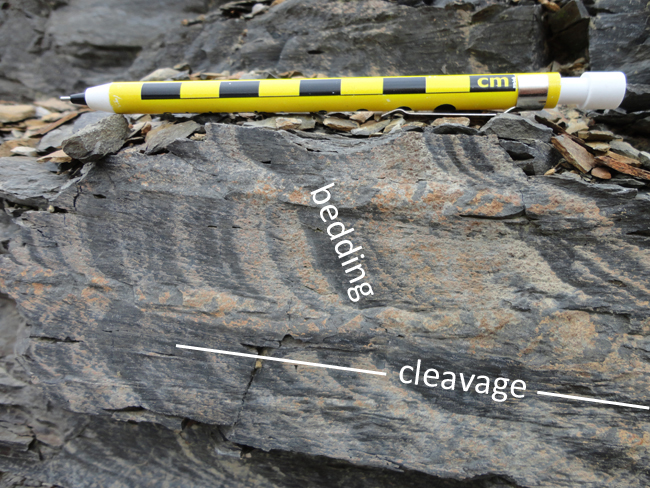Today, two examples of outcrops that reveal an overprinting relationship between metamorphic cleavage and sedimentary bedding. Both are Devonian in depositional age, from the new stretch of New Route 55 in West Virginia, west of Moorefield. The first is from limestones of the Helderberg Group, and the second is from shale of the Brallier Formation. In both cases, the metamorphic overprint came during the late Paleozoic Alleghanian Orogeny, the mountain-building episode that closed the Iapetus Ocean and built the supercontinent Pangea.




“Bedding/cleavage relationships” — it sounds so lascivious! But it’s really quite tame.
So are these rocks sedimentary or metamorphic?
I’d say the answer is, “yes.”

Yes! I see it! Thanks for posting. Maybe this weekend we will head out in search of this outcrop. Very cool.
You do a disservice to deformation. These Devonian sedimentary rocks are deformed, but have not, in any substantive way, been metamorphosed. The cleavage formed during deformation, likely by a combination of mechanisms (pressure dissolution, grain rotation, etc.) without significant recrystallization. This distinction is important because students commonly treat deformation and metamorphism as synonyms, but they should not. While metamorphic rocks are nearly always deformed, deformed rocks need not be metamorphosed. Folded, faulted, and cleaved rocks in fold-and-thrust belts like the Valley & Ridge are exemplars of deformation without metamorphism. Don’t dis deformation!
I appreciate the peer review. Be reassured that in my mind, deformation and metamorphism are indeed distinct and discernible phenomena that often overlap in time and place due to similarity of tectonic cause.
In my defense, however, I’d like to quote from the AGI Dictionary of Geological Terms, with italics representing my own emphasis:
……metamorphism The mineralogical, chemical and structural adjustment of solid rocks to physical and chemical conditions imposed at depth below the surface zones of weathering and cementation, which differ from the conditions under which the rocks originated.
and also:
……metamorphic rock Any rock derived from pre-existing rocks by mineralogical, chemical, and / or structural changes, essentially in the solid state, in response to marked changes in temperature, pressure, shearing stress, and chemical environment, generally at depth in the earth’s crust.
You’re absolutely 100% right that we don’t need metamorphism to have deformation, but I would argue that the development of slaty cleavage like this is step #1 on the path from diagenesis towards full recrystallization. Upon reading this comment, I thought to myself about what it would take to change these rocks *just* enough that they would qualify as unambiguous, proper low-grade metamorphic rocks. If we jacked up the pressure and temperature on these rocks, wouldn’t the cleavage become more pronounced? Do we need a phyllitic sheen to develop to call something “metamorphic”? Do we need full obliteration of pre-existing sedimentary structures?
My whole point in this post is that there’s a spectrum of rocks in the world, some of which are clearly sedimentary only, some of which are properly designated as metamorphic, and some of which straddle the fuzzy boundary between the two. I suggest that these outcrops provide boundary cases. Maybe I’m missing something.
So I guess what it boils down to is: Is slate (with slaty cleavage achieved through grain rotation and pressure dissolution) a metamorphic rock?
…And I would never dreaming of dissing deformation! Perish the thought! 🙂
The boundary for when rocks move into the “low temperature metamorphic” category is very hazy, but for me its when the clays (smectite and/or kaolinite specifically) react to become illite (low low temperature mica) in metasedimentary rocks. Problem is that differentiating between the various low temperature phyllosilicates is not possible in hand sample and difficult in thin section, moving you onto XRD to make the call. In the field, personally, I wouldn’t call it.
I think it might be interesting to also explore the relationship between when pressure solution, subgrain rotation, etc. occurred & when illite started crystallizing in this region.
And thanks for the bedding vs. cleavage pictures! I needed a few more for lectures 🙂
Thanks for chiming in. Happy to provide full-res versions of any image on the blog to educators – just let me know which ones you want.
I’d agree with Elli about the growth of illite (though there’s so much continuity between low-grade metamorphic and kinda-hot sedimentary – a continuous reaction in complex and difficult-to-identify minerals doesn’t make for a simple boundary!).
In addition, I don’t know if I would use pressure solution as an indicator, just because calcite can dissolve so easily at low temperatures.
Studies of smectite to illite transition in shales as a function of temperature in different sedimentary basins (nicely summarized in Jan Sroden’s 1984 Illite article in Reviews in Mineralogy and Geochemistry) show that illitization starts to occur at temps as low as 50ºC and is effectively complete at temperatures of ~100ºC. Given that complete illitization could be expected by burial to 4 km, this seems to me a quite low threshold to label a rock as metamorphic. But clearly as you say Elli the boundary is hazy and if we are thinking about the low-temperature metamorphic environment as one in which mineralogical transitions are happening—clearly that is occurring is illitization is happening.
It would be interested to see the rocks in the last picture in thin section.